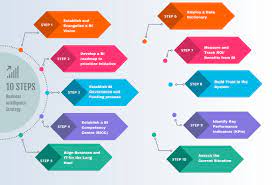
Successful Business Strategy
Introduction
The success of any business hinges on having a well-defined business strategy. A successful business strategy is about more than just setting goals and defining the path for achieving them. It’s about understanding the competitive environment, customer needs, and opportunities for growth. There are many different elements that need to be taken into consideration when developing a successful business strategy, such as market analysis, financial planning, organizational structure, and resource allocation. In this article we’ll look at what goes into creating a successful business strategy and how you can develop one of your own.
Market Analysis
The first step in developing a successful business strategy is to carry out an in-depth market analysis of your industry or sector. This involves researching the current competitive landscape to understand who else is operating in it, their strengths and weaknesses compared to yours and any potential threats they may pose. It also involves studying customer behavior – what are their needs? What do they want from you that your competitors aren’t offering? Carrying out an effective market analysis will help you identify areas where you could potentially gain an advantage over your competitors as well as areas where there may be unmet customer demand that you can capitalize on.
Financial Planning
Once you have conducted your market analysis it’s time to start planning financially for the future of your business. This involves making decisions such as how much capital should be invested in research & development (R&D), marketing campaigns etc., setting realistic targets for sales growth or profitability gains and calculating potential risks associated with each decision made along the way so these can be addressed accordingly if needed at a later stage down the line. Financial planning requires careful thought but done properly it will ensure that resources are allocated efficiently with minimal risk involved which will increase chances of success significantly over time .
Organizational Structure
Organizational structure refers to how activities are divided up within an organization – who reports to whom? Who takes responsibility for specific tasks or projects? Who makes decisions regarding certain issues etc.? Having clear organizational structures ensures that everyone knows their role within the company and allows those responsible for key tasks or projects to manage them effectively without having too much interference from other departments which could lead to delays or mistakes being made further down the line due lack of communication between teams or individuals involved in them . Furthermore , having well defined organizational structures also helps establish accountability throughout all levels within an organization so everyone understands who is ultimately responsible if something doesn’t go according plan .
Resource Allocation
After carrying out market analysis , financial planning ,and establishing organisational structure ,the next step towards developing a successful busineess straegyis reosurce allocation . This means deciding which resources (time , money etc.) should be dedicated towards specific tasks based on priority level set by management team . For example if certain project needs more attention then others then resources should allocated accordingly so those working on project don’t have divide thier attention among all other tasks while still ensuring necessary results achieved within set timeline frame given available budget constraints . Resource allocation essential part of ensuring efficient usage all available resorces without wasting time energy money .
Implementation
Finally once all element mentioned above have been taken care off its important implement eveything discussed thus far intot he real world setting by putting together action plan detailing steps needed take order reach objectives identified during previous stages process this includes assigning responsibilities timeline expectations meetings deadlines improvisation strategies contingency plans ect depending individual situation each company unique when comes implementation therefor cannot use same approach across board instead must tailor make fit particular organisation’s requirements order ensure best possible outcome terms results achieved quality service provided customers satisfaction levels overall efficiency operations department employees morale etcetera Conclusion Developing effective busineses strategie no easy feat requires lot effort dedication discipline consitency hard work good team support however done properly allow reap rewards years come increase chances survival during tough times boost competitve edge against rivals create sustainable profitable longterm future organisation